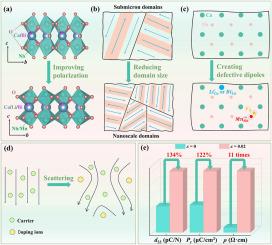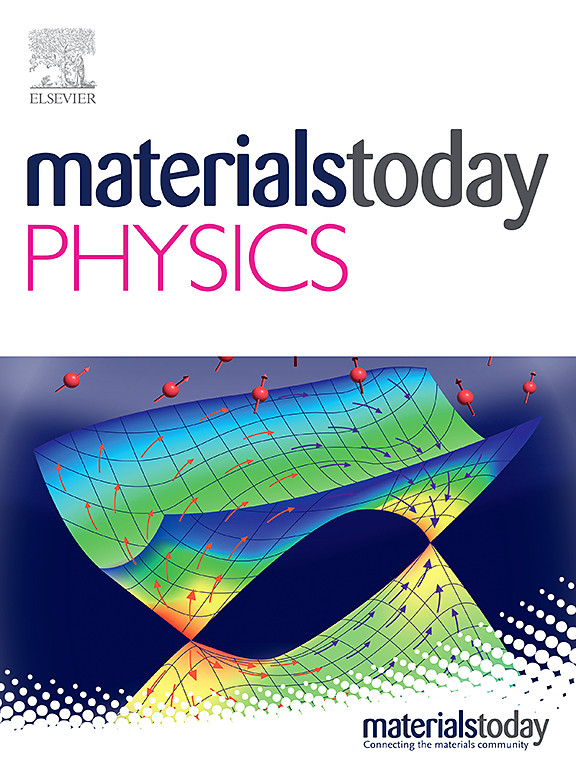通过共取代 CaBi2Nb2O9 陶瓷实现超高电阻率和出色的压电特性
IF 10
2区 材料科学
Q1 MATERIALS SCIENCE, MULTIDISCIPLINARY
引用次数: 0
摘要
CaBi2Nb2O9 (CBNO) 陶瓷在开发适用于航空航天、冶金和核电站等极端环境的压电传感器方面具有巨大潜力。虽然之前的研究已经增强了 CBNO 陶瓷的压电响应,但它们在高温下的绝缘性能仍有待改进。在这项工作中,设计了在 A 位上共取代 (Li0.5Bi0.5) 和在 B 位上共取代 Mn 的方法,以改善 CBNO 陶瓷的电气性能。锰和氧空位之间的结合所引起的缺陷偶极子限制了氧空位在高温下的移动。同时,用(Li0.5Bi0.5)共同取代 Ca 既降低了烧结温度,又减少了烧结过程中 Bi2O3 的挥发。通过这种改性,Ca0.96(Li0.5Bi0.5)0.04Bi2Nb1.98Mn0.02O9 陶瓷在 600 ℃ 时的超高温度系数为 928 ℃,电阻率为 2.85 MΩ-cm 。此外,该陶瓷还具有出色的压电特性(d33 为 15.2 pC/N,kp 为 6.9%)、铁电特性(Pr 为 9.42 μC/cm2)和热稳定性(在 900 °C 下退火 2 小时后,d33 退化率仅为 6%)。这项研究为在 CBNO 系统中同时实现高压电响应和出色的绝缘性能提供了一种实用策略。本文章由计算机程序翻译,如有差异,请以英文原文为准。

Achieving ultra-high resistivity and outstanding piezoelectric properties by co-substitution in CaBi2Nb2O9 ceramics
CaBi2Nb2O9 (CBNO) ceramics exhibit significant potential in the development of piezoelectric sensors suitable for extreme environments such as aerospace, metallurgy, and nuclear power plants. While previous studies have enhanced the piezoelectric response of CBNO ceramics, their insulating properties at high temperatures still require improvement. In this work, co-substitution of (Li0.5Bi0.5) at A site and Mn at B site was designed to improve the electrical properties of CBNO ceramics. Defect dipoles induced by the bound between Mn and oxygen vacancies restrict the movement of oxygen vacancies at high temperatures. Meanwhile, co-substitution of Ca by (Li0.5Bi0.5) reduces both the sintering temperature and volatilization of Bi2O3 during the sintering process. This modification results in an ultra-high TC of 928 °C and an exceptional resistivity of 2.85 MΩ·cm at 600 °C for Ca0.96(Li0.5Bi0.5)0.04Bi2Nb1.98Mn0.02O9 ceramics. Furthermore, the ceramic exhibits excellent piezoelectric properties (d33 of 15.2 pC/N and kp of 6.9%), ferroelectric properties (Pr of 9.42 μC/cm2), and thermal stability (degeneration of d33 only 6% after annealing at 900 °C for 2 h). This work offers a practical strategy for simultaneously achieving both a high piezoelectric response and outstanding insulating properties in the CBNO system.
求助全文
通过发布文献求助,成功后即可免费获取论文全文。
去求助
来源期刊

Materials Today Physics
Materials Science-General Materials Science
CiteScore
14.00
自引率
7.80%
发文量
284
审稿时长
15 days
期刊介绍:
Materials Today Physics is a multi-disciplinary journal focused on the physics of materials, encompassing both the physical properties and materials synthesis. Operating at the interface of physics and materials science, this journal covers one of the largest and most dynamic fields within physical science. The forefront research in materials physics is driving advancements in new materials, uncovering new physics, and fostering novel applications at an unprecedented pace.
 求助内容:
求助内容: 应助结果提醒方式:
应助结果提醒方式:


